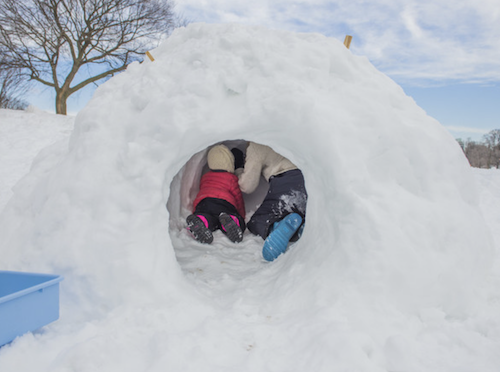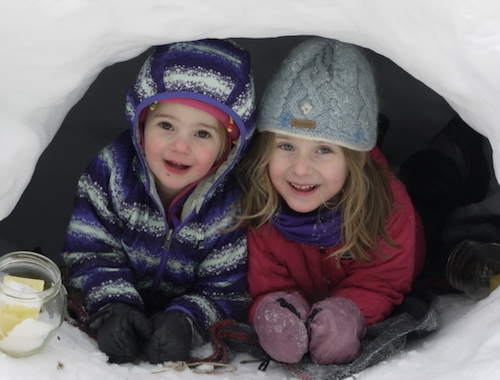Build a Snow House
-
Age: 0 to 8+
-
Time: 1 hour+
-
Materials: Snow shovel; garden trowel; lanterns or flashlights; wool blanket; sticks
- Skills: Imagination, Behavioral Schema, Sensory, Empathy
When life gives you snow, make a snow house—aka a "quinzhee." This activity makes use of what’s all around you (literally). Kids will gain empathy for the animals who make their homes outdoors all year round, and you might just find yourself making friends with winter again…at least for a couple hours.
What is a quinzhee? A snug snow hut that provides shelter during even the wintriest winter. It takes under two hours to build with one of those hours just waiting for snow to settle—and kids will spend countless more hours decorating it, hosting parties in it, and hiding out in it, even in single-digit weather. Add a small lantern when the day grows dim and voila, you’ve rekindled the magic of winter.
This activity is featured in our January 2023 Calendar. Click to get your free copy and sign up to get a fresh, new calendar each month!
This activity is featured in our January 2023 Calendar. Click to get your free copy and sign up to get a fresh, new calendar each month!
The Guide
Wonder Together.
Bunnies manage to stay warm and cozy all winter long. How do they do it? Their fur coats probably help, but maybe they make a little room where they can huddle up. Could you make a little room, too? What would you use? How about snow house?
Brainstorm and plan.
To start to make a snow house, you need to make a big mound of snow at least 4 feet high and 5-6 feet in diameter. Brainstorm with your child what kinds of things you need to make that mound. Gather tools like shovels, bowls, scoops or even just big spoons. You'll also need about a dozen sticks that are about 12 inches long.
Make a mound.
You won’t need an architect’s plans for this building project. Once you’ve found a spot, begin making your mound
Go play while the snow settles.
You need to let the mound settle for an hour so the snow crystals can bond together. Meanwhile, enjoy some snow play, a little tea or hot cocoa break or some more gathering. You'll need about a dozen twigs or branches, each broken int foot-long sticks.
Dig out your house.
- Pat down the exterior of your mound, then push the sticks into it, all around the sides.
- Decide with kids where the door should be, and use that spot to begin scooping and hollowing out the middle. If this part is hard for little ones, they can engage with an important job, such as filling bucket with snow to make a table later on.
- Once your doorway is wide enough for kids to crawl in and out, start digging out the snow. Dig in every direction until you touch the tip of one of the sticks. Once you hit a stick, stop digging in that direction; this will ensure your walls are about a foot thick.
- Then, use the point of a stick or a small shovel to poke a small air hole in the back to allow for air flow. You're there!
Play in your snow house!
First, establish (snow) house rules. No kids in the quinzhee without adult supervision, no climbing on top, and no hitting the insides of the walls.
Now the fun begins!
Now the fun begins!
- Bring out a few props, like an old blanket for a rug and a flashlight or camping lantern for light.
- Encourage kids to build a stove, table, or sink from snow. (Construction will probably have to take place outside the quinzhee.)
- A few stuffed animals, a couple plates from indoors, and before you know it, a tea party will be underway—on ice.
- In the evening, bring lights to place in or on your snow house and behold—winter magic!
Risk Management: As with so many truly enriching play experiences, a snow house comes with risks. Follow directions carefully when you build, allowing at least an hour for the mound to settle and leaving at least a foot on all surfaces. Adults must keep a watchful eye as they allow children to play freely, making sure that the structure does not get compromised. We also teach children about how and why we never climb on the outside of the snow house. As with all things, these become wonderful lessons and keeps safe risk taking a part of our children's lives!
Why is this activity great for kids?
Tucking their bodies into small, enclosed spaces is not just a perennial favorite for small children—it’s also brain/body coordination work that falls into a set of play behavior patterns known as behavioral schema. Kids engage multiple senses as they explore the sights, scents, textures, and even temperatures of snow play. Playing house is a powerful imaginary exercise that gives children the opportunity to emulate the people most important to them (you!). The quinzhee lends itself to cozy, rich sensory experiences, such as steaming hot cocoa or tea and a flickering lantern against the dark, cold afternoon. These are the kinds of memories children hang on to well into adulthood. And perhaps best of all, sustained outdoor activity often leads to deep sleeps later that evening. Enjoy!





